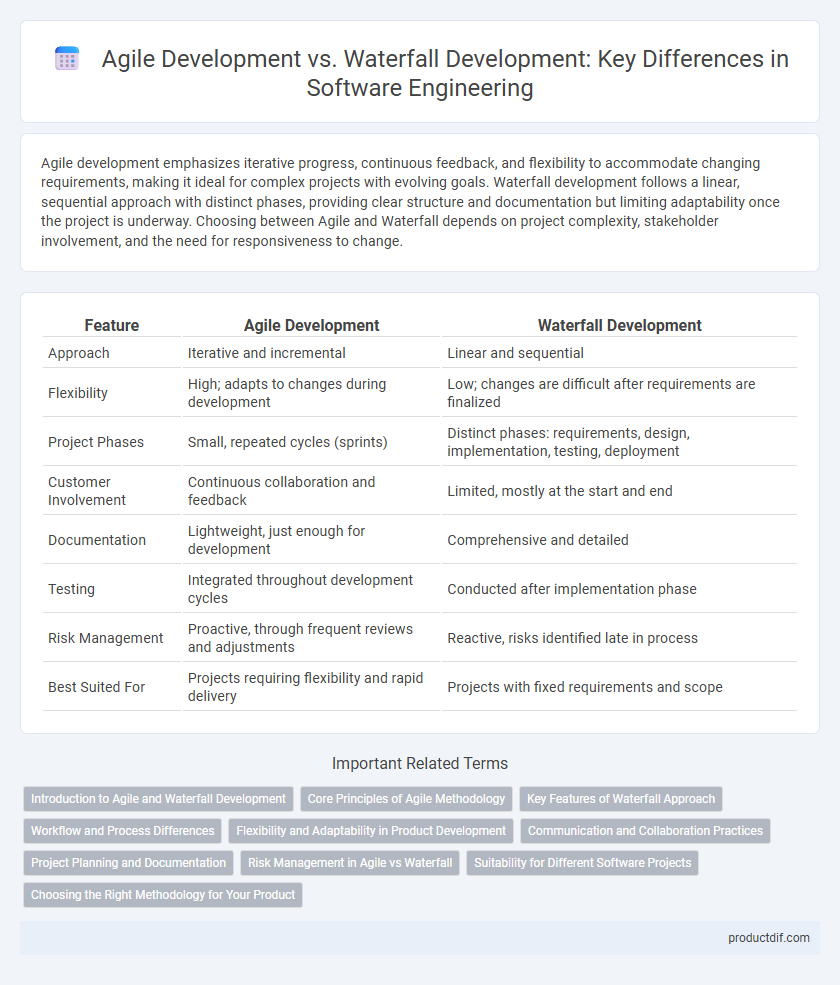Agile development emphasizes iterative progress, continuous feedback, and flexibility to accommodate changing requirements, making it ideal for complex projects with evolving goals. Waterfall development follows a linear, sequential approach with distinct phases, providing clear structure and documentation but limiting adaptability once the project is underway. Choosing between Agile and Waterfall depends on project complexity, stakeholder involvement, and the need for responsiveness to change.
Table of Comparison
| Feature | Agile Development | Waterfall Development |
|---|---|---|
| Approach | Iterative and incremental | Linear and sequential |
| Flexibility | High; adapts to changes during development | Low; changes are difficult after requirements are finalized |
| Project Phases | Small, repeated cycles (sprints) | Distinct phases: requirements, design, implementation, testing, deployment |
| Customer Involvement | Continuous collaboration and feedback | Limited, mostly at the start and end |
| Documentation | Lightweight, just enough for development | Comprehensive and detailed |
| Testing | Integrated throughout development cycles | Conducted after implementation phase |
| Risk Management | Proactive, through frequent reviews and adjustments | Reactive, risks identified late in process |
| Best Suited For | Projects requiring flexibility and rapid delivery | Projects with fixed requirements and scope |
Introduction to Agile and Waterfall Development
Agile development centers on iterative progress through small, cross-functional teams, promoting flexibility and continuous feedback to adapt to changing project requirements. Waterfall development follows a linear and sequential approach with distinct phases such as requirements, design, implementation, testing, and deployment, emphasizing thorough documentation and upfront planning. Understanding these methodologies' core principles helps organizations select the most suitable framework for their software development projects based on complexity, stakeholder involvement, and delivery timelines.
Core Principles of Agile Methodology
Agile methodology emphasizes iterative development, customer collaboration, and adaptive planning, contrasting with the linear, sequential approach of Waterfall development. Core principles include delivering small, functional increments frequently, embracing change throughout the project lifecycle, and fostering direct communication among cross-functional teams. This flexibility enables faster feedback, continuous improvement, and higher responsiveness to evolving requirements in software projects.
Key Features of Waterfall Approach
The Waterfall development approach follows a linear and sequential process with distinct phases such as requirements gathering, design, implementation, testing, and maintenance. Each phase must be completed before the next begins, ensuring structured documentation and clear milestones. This methodology emphasizes upfront planning, fixed scope, and limited client involvement during the development cycle.
Workflow and Process Differences
Agile development emphasizes iterative workflows with continuous feedback loops, enabling adaptive planning and rapid delivery of functional software in short sprints. Waterfall development follows a linear, sequential process where each phase--requirements, design, implementation, testing, and maintenance--must be completed before moving to the next, limiting flexibility for changes once a phase is finished. Agile fosters collaboration and incremental improvements, whereas Waterfall relies on comprehensive documentation and predefined milestones to guide project progression.
Flexibility and Adaptability in Product Development
Agile development offers superior flexibility and adaptability by enabling iterative progress and continuous feedback, allowing teams to respond swiftly to changing requirements and market demands. In contrast, Waterfall development follows a rigid, linear process that limits the ability to make adjustments once a phase is completed, potentially delaying response to evolving project needs. Emphasizing Agile methodologies enhances product development by fostering collaboration, rapid prototyping, and incremental delivery, which better align with dynamic business environments.
Communication and Collaboration Practices
Agile development emphasizes continuous communication and collaboration through daily stand-ups, sprint planning, and cross-functional team interactions, enabling rapid feedback and adaptability. Waterfall development follows a linear, sequential approach where communication is often formal and occurs primarily at project milestones, limiting real-time collaboration. Agile's iterative cycles foster ongoing stakeholder engagement, while Waterfall's rigid structure can create communication silos, impacting responsiveness to changes.
Project Planning and Documentation
Agile development emphasizes adaptive project planning with iterative cycles, enabling continuous feedback and flexible adjustments throughout the project lifecycle. Documentation in Agile is lightweight and just-in-time, prioritizing working software over comprehensive records. In contrast, Waterfall development follows a linear, predefined project plan with extensive upfront documentation to detail every phase before implementation begins.
Risk Management in Agile vs Waterfall
Agile development emphasizes iterative progress and continuous feedback, enabling early identification and mitigation of risks throughout the project lifecycle. In contrast, Waterfall development follows a linear, sequential approach where risk is typically assessed upfront, potentially leading to overlooked issues during later stages. Agile's adaptive risk management reduces uncertainties by allowing teams to respond swiftly to changes, whereas Waterfall's rigid structure may result in higher risk exposure if initial assumptions prove incorrect.
Suitability for Different Software Projects
Agile Development excels in dynamic projects requiring frequent updates and user feedback, making it ideal for software with evolving requirements, such as startups and web applications. Waterfall Development is better suited for projects with well-defined, stable requirements, like government or large-scale enterprise systems, where strict timelines and documentation are critical. Choosing between the two depends on project complexity, flexibility needs, and stakeholder involvement.
Choosing the Right Methodology for Your Product
Selecting the appropriate development methodology depends on project scope, flexibility needs, and team collaboration. Agile Development excels in dynamic environments with evolving requirements, promoting iterative progress and continuous feedback. Waterfall Development suits well-defined projects with clear, fixed objectives, emphasizing a sequential design process and thorough documentation.
Agile Development vs Waterfall Development Infographic

 productdif.com
productdif.com